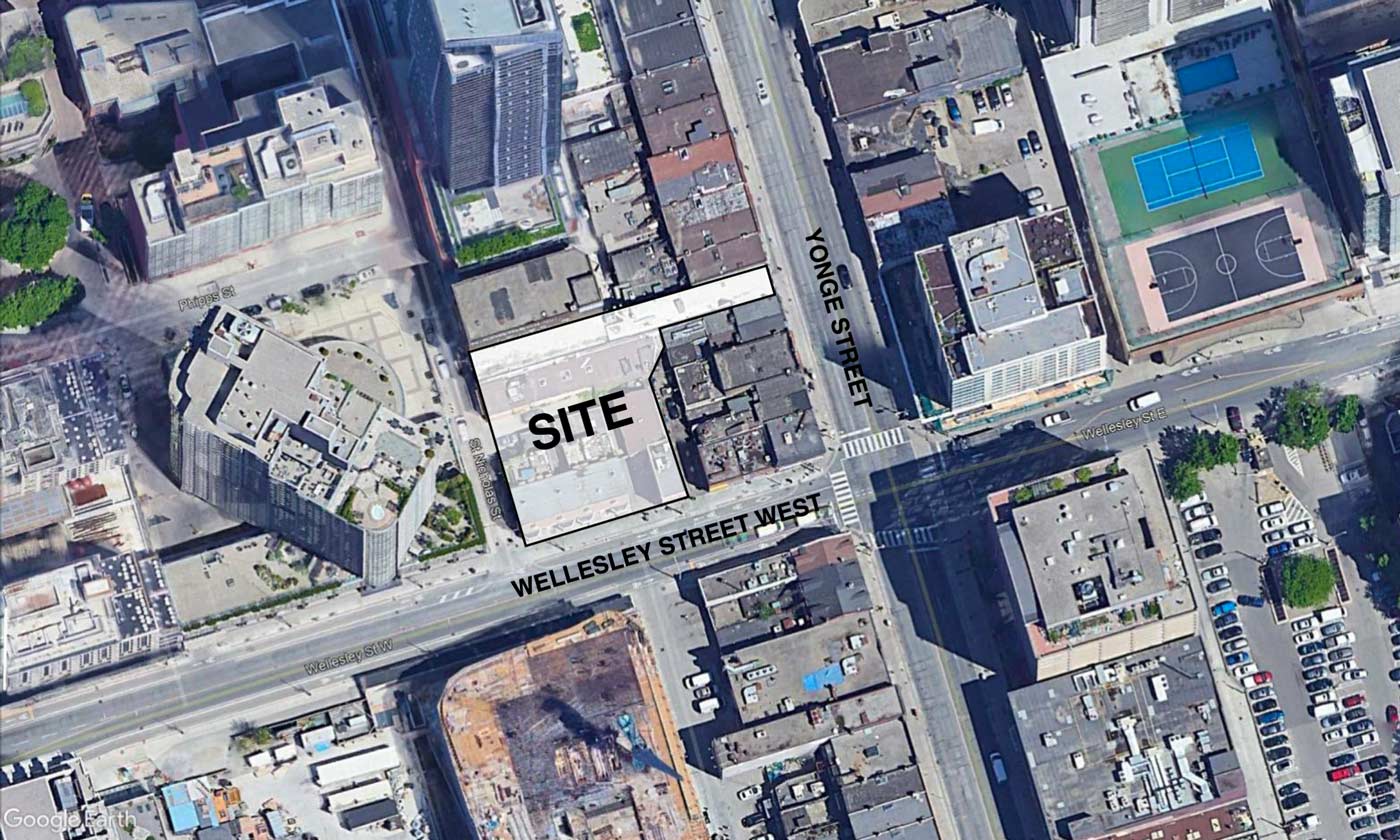Construction Management Plan
Introduction
8 Wellesley is a 55 storey mixed–use, development located at 6-16 Wellesley Street West, 5-7 St. Nicholas Street and 586 Yonge Street. The Site is located at the northwest corner of Yonge Street and Wellesley Street West, in the City of Toronto. The proposed development includes 600 residential units and 470 m2 of retail.
The following streets or existing buildings borders the project site:
– North Side: 9 St Nicholas Street
– South Side: Wellesley Street West
– East Side: Bistro Lane
– West Side: St Nicholas Street
The excavation depth from the street level is approximately 20 metres below grade and extends to the lot lines on all four sides of the property. Caisson wall will be provided for excavating the site complete with a system of tiebacks and rock pins. The building is being fully enclosed along the perimeter. The height of the building at the highest point it is approximately 182 metres above street level.

Construction Sequence
This stage of construction includes the following activities:
-
- Construction of retention system
- Installation of ballasts
- Tie-ins to existing heritage façade
- Demolition
During the heritage retention stage construction vehicular activities are anticipated to be moderate. The anticipated type of construction vehicles are predominately large flatbed tractor trailer trucks for steel delivery and rubbish trucks.
2.2 STAGE II – BELOW-GRADE CONSTRUCTION
This stage of construction includes the following activities:
-
- Completion of detailed excavation for footings and sub-slab drainage;
- Installation of sub-slab drainage;
- Pouring of footings;
- Erection of tower crane;
- Installation of Site servicing connections;
- Installation of blindside waterproofing;
- Pouring of foundation walls; and
- Pouring of concrete slabs.
During the below-grade construction stage, construction vehicular activities are anticipated to be heavy. The anticipated type of construction vehicles are predominately concrete trucks. To a lesser extent other construction related vehicles are anticipated, such as large flatbed tractor trailer trucks for steel delivery and other delivery vehicles such as single-unit trucks and typical cube-vans. Approximately 3 to 6 trade vehicles and 15 concrete vehicles per day are anticipated during this stage. Steel deliveries are expected 5 times per week and will typically be scheduled for early morning delivery.
2.3. STAGE III– ABOVE-GRADE CONSTRUCTION
This stage of construction includes the following activities:
-
- Completion of above-grade structure;
- Enclosure of building envelope;
- Installation of roofing;
- Installation of windows; and
- Installation of precast masonry.
During the above-grade construction stage, construction vehicular activities are anticipated to be heavy. The anticipated type of construction vehicles are predominately concrete trucks. To a lesser extent other construction related vehicles are anticipated, such large flatbed tractor trailer trucks for steel delivery and other delivery vehicles such as single-unit trucks and typical cube-vans. Approximately 8 to 10 trade vehicles and 10 to 15 concrete vehicles per day are anticipated during this stage. Steel deliveries are expected 5 times per week and will typically be scheduled for early morning delivery.
2.4. STAGE IV – COMPLETION OF INTERIOR FINISHES
This stage of construction includes the following activities:
-
- Erection of interior stud walls (framing, insulation, drywall);
- Installation of internal mechanical and electrical systems;
- Millwork;
- Installation of flooring; and
- Painting.
During this construction stage, construction vehicular activities are anticipated to be moderate. The anticipated type of construction vehicles are predominately delivery vehicles such as single-unit trucks and typical cube-vans. Approximately 8 to 12 trade vehicles per day are anticipated during this stage.
2.5. STAGE V – STREETSCAPE/ BOULEVARD WORKS
This stage of construction includes the following activities:
-
- Landscaping (on-grade, street boulevards, and podium structures – including terraces and green roofs);
- Installation of new curbs and sidewalks;
- Installation of street lighting to the internal project, with landscape structural elements;
- Re-instatement of street furniture and utilities (if applicable) removed to facilitate construction;
- Installation of post-construction regulatory and warning traffic signage;
Construction vehicular activities are anticipated to be low, with the majority of vehicles being dump trucks and small delivery trucks (typical cube-vans). Approximately 6 construction vehicles per day are anticipated during this stage.
Construction Management Plan
A Construction Management Plan (CMP) will be implemented during construction. The overall objective of the CMP is to address the construction logistics associated with the construction of the proposed development.
-
- All Ministry of Labour requirements and safety polices will be strictly adhered;
- Compliance with the Occupational Health and Safety Act;
- All construction protocols will conform to City of Toronto By-Law requirements with respect to noise control, dust control and construction operation period.
- Traffic control persons will be utilized when required to direct traffic and cyclist activity;
